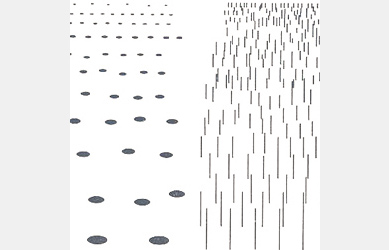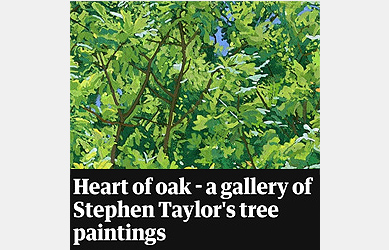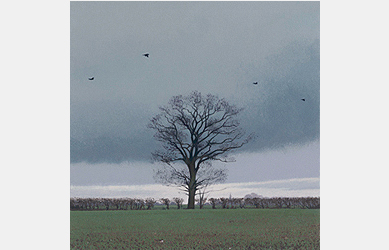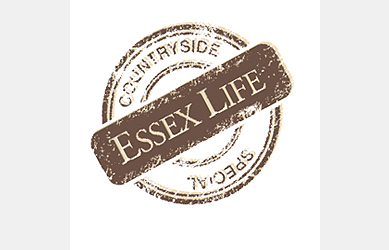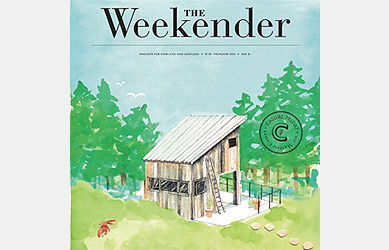Landscape painting may look like a dying art, but experience tells me this is wrong. Not only do children draw and paint what's around them, amateur painting flourishes and there is an international market for landscape in the private sector.
Most of this activity is not described as public art, but I think that paintings of place used in the private sphere have a continuing role in the construction of meaningful places in the public realm.
Places in the home
Walk down any street in the evening, when lights are on and blinds not yet drawn, and you will see images on walls : family reference points that say who, and where, we are. Images of landscape hung in the living space are a daily reminder of places outside the home and can be an imaginative measure of how far away they are. Such pictures help us to feel connected, though personal, family or group experience, with the places represented. Some of these places might be fictitious or very distant, but others will be much closer to home.
This imaginative connection takes place across generations. Asked recently what his most precious possession was the writer William Boyd answered "There's a small amateurish oil painting my father did of his family home in Cupar, Fife, shortly before he died that is unique and irreplaceable." The novelist Philip Hensher describes for a magazine what is on his walls "not much...but I do have a painting by my dad of Topsham, the town in Devon where I live". My grandfather was a brewery clerk, in Smethwick in the West Midlands, who painted at weekends. His picture of an almost pre-industrial valley where his own father lived one hundred years ago now hangs on my cousin's wall. It will be passed on to children not yet born.
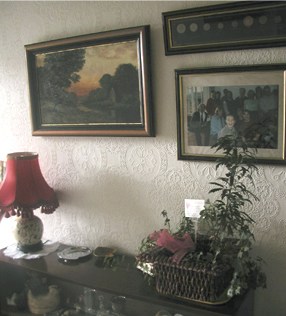
Remembering places works well with photographs, but few photos express the effort and attention of pictures made with pencil or paint. This physical intimacy reinforces the sense of something "unique and irreplaceable" and seems particularly direct if a member of the family has made the picture. If a friend makes the image the circle is wider and if made by an artist - in this context a relatively public figure - the connections between spectator and place will be less direct, but more widely distributed.
What strikes me about the landscape of place in the home is its sanity. Rather in the way pictures of family confirm important relationships, pictures of places in the home suggest that what is outside means something to us. Almost all of us use images like this. Without them, disorientation and anxiety are a step closer. I saw a Romanian woman recollect for television her forced eviction from home under Ceausescu. She could not put into words what she'd lost. After a long silence all she could manage was "we had to leave our pictures."
Private to public and public to private
Placemaking in this visual culture includes makers and users, and within it meaningful places tend to be personal and could be anywhere. But this doesn't mean that paintings of place in the home have no public dimension. There are many connections.
Exchange between private and public art is underwritten by continuity between amateur and professional work. Although artists generally cross from one status to the other in a piecemeal process of market and cultural validation, the forces that present professional art as different in kind naturally tend to suppress the connections. But I think a theory of interdependence is waiting to be written.
Anyone who has ever tried to draw or paint can see in professional work at least some expression of their own activity. Confronted with very good work this can elicit a feeling that's the opposite of arrogance or envy: Well done! Not just for you, but for us. This often unconscious fellow feeling is supported by familiarity with production, not just consumption, helped along by being able to see the trace of work in the image itself. Even in The National Gallery, affect has this private dimension.
Picture hanging is another link between private and public art. Interior design history has been a poor relation of art history, but an anthropologist would pay serious attention to how images were organised around the home. Curators alive to this can tap into a readymade sympathy for the public display of paintings.
My own work converts private experience of nature into sharable objects, which then move between private and public realms. What comes out of my house may go to a gallery, be seen on a website or in print, then typically goes back into private homes into rooms used by individuals, family and friends. If a painting is sold to a company it might be hung in a private office or a public foyer. I conclude that, outside of permanent display in a public collection, and perhaps not even then, there is no exclusively public dimension to movable pictures. Yet the images do have a public life.
Where are we?
It is the business of a painter not to contend with nature & put this scene (a valley filled with imagery 50 miles long) on a canvas of a few inches, but to make something out of nothing...
Letter from John Constable to Archdeacon Fisher, Friday August 6th, 1824.
We see the world around us but may not notice it. Our sense of place varies in density and meaning because meaning comes through experience, attention and feeling, and we cannot bring these things to everything.
In my case personal loss of family and loved ones made me rethink my work mid career and concentrate on observing a single field in North Essex, near where I live. I made paintings of it for seven years. Through farmers, local naturalists and even a glider pilot I came to know more about the field, but what I brought to it was the emotional and visual attention of painting. As a result the field has become a place in painting.
Mutuality between the private and public display of paintings points to something about our private and public sense of place. In a gallery or living room 'my' field is not recognised as a particular field on a map. But, depending on your starting point, it is recognisable as somewhere in a temperate zone, Europe, England, Essex. So a private experience, as a work of art, becomes a small contribution to a public sense of place, subject to interpretation and the private experience of others. Its an idea of public place that is particular in reference but general in reach and, crucially, is supported by the affective potential of painting.
In this way landscape painting not only helps to show us where we are, it helps us to feel it too. Of course quality matters, but the function of landscape painting in this sense is independent of ranking. It's sympathy with the activity that counts.
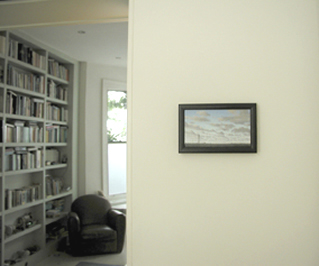
Renewal
We can send video clips of where we are by phone to the other side of the world. Google Earth is a visual world where anyone can see anywhere. But people still have paintings of place on the wall. Why?
Because of the wall. We've been sheltering from nature since Lascaux, and images on the wall are the background to daily life in a protected space. Because of its familiarity, its easy to overlook the almost existential aspect of this set up. But it seems to me that rigid shelter and stable images of what's out side are a part of life. Perhaps it's the same familiarity, set against the newness of new media, that suggests landscape painting is incapable of renewal.
But there are many ways our environment can be seen and painted afresh. Science, for one thing, has given us new things to notice. And we have a new motivation: as the contemporary nature writer Robert MacFarlane puts it, "a factually based but imaginative restructuring of our relationship with nature is crucial for the future of human civilization".That such an idea could be even slightly expressed by a picture you see every day is surely, as I say, sane.
This is not to dismiss the invention of new forms of public art, but I am asking art professionals to reconsider and freshly connect with the way people imagine places through what is, after all, their own art. Their activity has a history that dynamically involves individuals and families with the world around them, and this is part of its valuable, public meaning.
notes
1. For an art historical view of the importance of popular responses to realist art see David Greenberg. The Power of Images, studies in the history and theory of response. University of Chicago Press, 1989. Chapter 15 summarises his views.
2. For a technical discussion of distributed objects and the extended mind see the last chapter of anthropologist David Gell. Art and Agency, an anthropological theory. OUP. 1998.
3. Julian Stallabras. Art Incorporated. OUP 2004, is a broadly Marxist account of contemporary patronage, including public art. As a contrast to the political and economically driven professional art he has been surveying he concludes with a tantalising aside :"it can be" that "the local liberation offered in the production of art, and its enjoyment, are genuine." But he has not to my knowledge followed up the implications of this 'local production' for the majority of artists in the world, who are both local and non professional.
4. American artist Chuck Close said "I always thought that one of the reasons why a painter likes especially to have other painters look at his or her work is the shared experience of having pushed paint around" (www.artknowledgenews.com). This idea crosses the boundaries of amateur and professional.
5. Jules Pretty. The Earth Only Endures. Earthscan, 2007, is an ecological, economic and cultural analysis of our global connections to land. Each chapter is headed with a landscape painting by his father. The title of this article owes a special debt to Jules, who took time out to help me when I was trying work out what I was doing in my field. One thing I took from our discussion was a much richer concept of place making. www.julespretty.com
6. William Boyd interview with Rosanna Greenstreet, Guardian Weekend, 3 February, 2007.
7. Philip Hensher interview with Tim Burrows, Telegraph Magazine , 21 March 2009.
